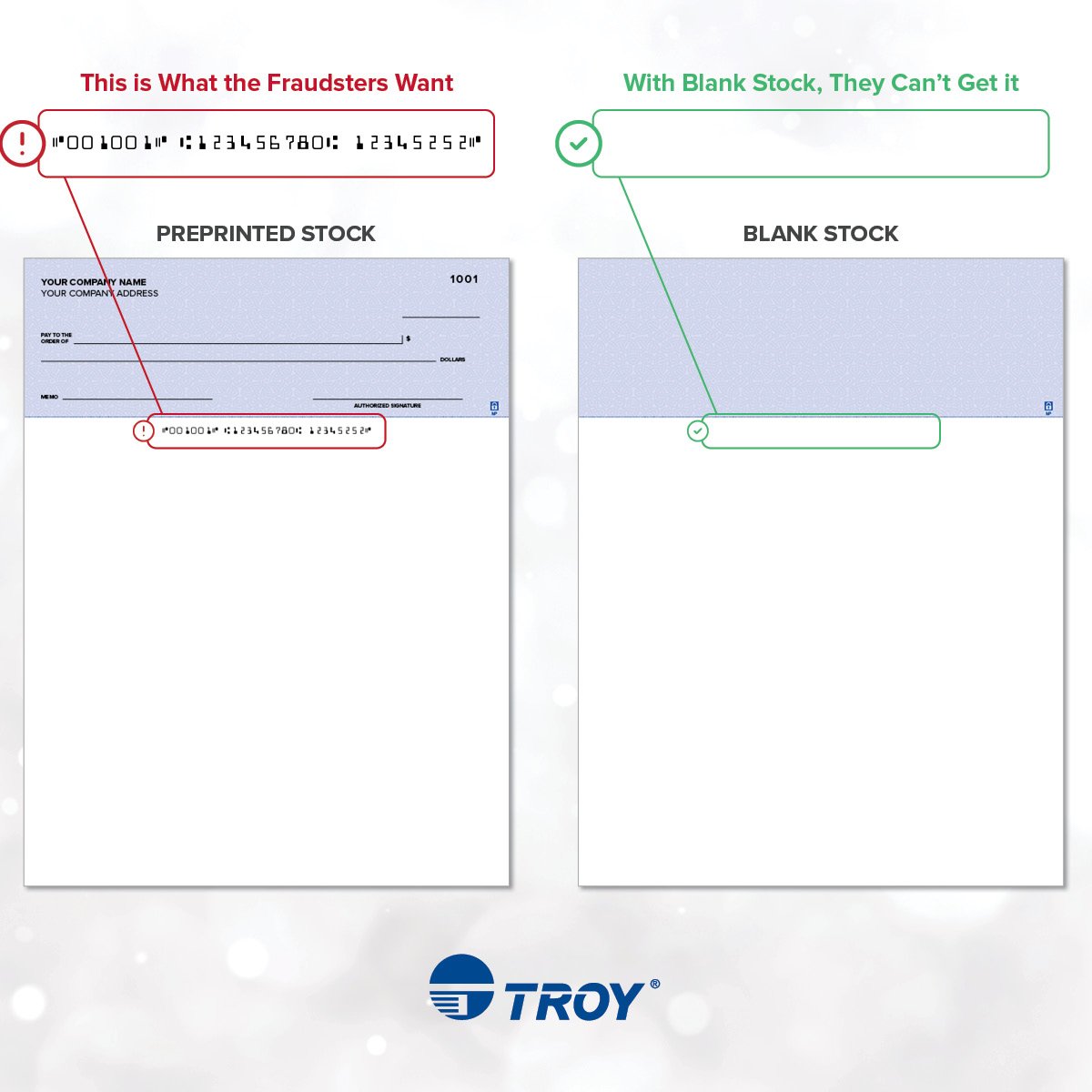Chèques pré-imprimés et chèques vierges - Savoir faire la différence

Dans le domaine des transactions financières des petites et grandes entreprises, l'humble chèque en papier continue de jouer un rôle important malgré l'ère numérique dans laquelle nous vivons. Le choix entre l'utilisation de chèques vierges et de chèques pré-imprimés peut sembler une décision mineure, mais elle peut avoir de profondes implications en termes de sécurité et de flexibilité. Dans cet article de blog, nous examinerons les avantages des chèques vierges et les raisons pour lesquelles ils constituent le meilleur choix lorsqu'il s'agit d'atténuer les risques de fraude.
Quelle est la différence entre un stock de chèques vierges et un stock de chèques préimprimés ?
Les différences peuvent sembler évidentes au vu des noms des deux types de chèques, mais elles peuvent vous surprendre. Il est essentiel de comprendre la distinction pour décider lequel utiliser. Examinons les deux types de chèques :
Qu'est-ce qu'un stock de chèques préimprimés ?
Les chèques préimprimés contiennent toutes les informations nécessaires déjà imprimées, y compris le numéro de compte bancaire, le numéro d'acheminement et éventuellement le nom du bénéficiaire.
Qu'est-ce qu'un chèque en blanc ?
Les chèques vierges ne comportent pas d'informations préimprimées sur les comptes. Les utilisateurs doivent saisir les informations nécessaires à l'aide d'un logiciel de rédaction de chèques ou d'une imprimante conçue à cet effet.
L'utilisation de chèques préimprimés peut sembler banale et plus pratique. Elle ne nécessite pas d'impression supplémentaire, de matériel, ni les connaissances nécessaires à l'utilisation de tels outils. Les particuliers qui émettent régulièrement des chèques ne voudraient pas avoir à imprimer toutes les informations relatives à leur compte avant d'émettre un chèque, et les grandes entreprises qui traitent des milliers de chèques par mois, voire par jour, pourraient même voir les avantages de l'utilisation de chèques préimprimés - mais les deux parties devraient être en mesure d'identifier l'éléphant qui se trouve dans la pièce. Pouvez-vous deviner de quoi il s'agit ?
Vous l'avez compris ! Les chèques préimprimés sont une véritable mine d'or pour les fraudeurs. Si un fraudeur met la main sur un chèque préimprimé, il a accès aux numéros de compte et d'acheminement, ainsi qu'au nom du bénéficiaire, sans avoir à faire la moindre recherche. Il peut également utiliser des tactiques telles que le lavage de chèque pour modifier toute information à son avantage, ou aller jusqu'à créer des chèques contrefaits.
Si le lavage de chèques ou la contrefaçon peuvent sembler des pratiques que notre société actuelle a dépassées, il ne faut pas s'y tromper. Le lavage de chèques a fait son retour ces dernières années, tout simplement parce qu'il s'agit d'une méthode de fraude fiable que la plupart des entreprises et des gens n'anticipent pas. En octobre 2022, la chaîne ABC a réalisé un reportage sur les systèmes de lavage de chèques. Bien que le rapport se concentre principalement sur la fraude à l'encontre des particuliers, les entreprises courent un risque encore plus élevé en raison de leurs portefeuilles importants, de leurs longues procédures et de leurs comptes bancaires, où un montant de 5 000 dollars peut être dérisoire.
Qu'est-ce qui fait de l'action "chèque en blanc" la meilleure option ?
Les chèques vierges présentent un avantage considérable par rapport aux chèques pré-imprimés. Non seulement il met automatiquement en place des mesures de sécurité en éliminant complètement les informations sur les comptes exposés, mais il présente également d'autres avantages, notamment la réutilisation et la rentabilité :
- Risque de fraude réduit : Contrairement aux chèques pré-imprimés, les chèques vierges exigent que l'utilisateur saisisse le nom du destinataire et le montant, ce qui rend plus difficile l'exécution de transactions non autorisées par des fraudeurs.
- Flexibilité : Les entreprises doivent fréquemment modifier les informations relatives à leurs comptes et à ceux de leurs clients. Les chèques vierges s'adaptent facilement à ces changements, ce qui évite d'avoir à se débarrasser de chèques préimprimés périmés.
- Rentabilité : Les chèques préimprimés nécessitent souvent des commandes en gros, ce qui peut entraîner un gaspillage si tous les chèques ne sont pas utilisés. Le stock de chèques vierges élimine ce gaspillage en vous permettant d'imprimer des chèques selon vos besoins, ce qui vous permet d'économiser sur le papier à chèques.
Ligne de défense des produits de TROY
Chez TROY, nous reconnaissons l'importance du stock de chèques en blanc, mais nous savons aussi qu'il ne s'agit que de la première étape du processus de sécurisation de l'avenir de votre entreprise. Les avantages sont là, mais que se passe-t-il ensuite ? Peut-on encore être victime d'une fraude même après avoir mis en place un stock de chèques en blanc ? La réponse est oui, mais TROY dispose d'une gamme de produits de défense totale lorsqu'ils sont associés.
- Chèques en blanc : La gamme de chèques vierges TROY offre la technologie la plus récente pour empêcher la copie frauduleuse, l'altération et la contrefaçon tout en se conformant aux exigences du secteur des services financiers en matière d'imagerie et de compensation des chèques.
- Toner MICR Secure : Le Toner MICR Secure de TROY utilise de l'encre MICR standard et y ajoute une caractéristique de sécurité spéciale et brevetée : un colorant rouge qui se libère à chaque tentative de lavage de chèque, alertant immédiatement les banques de la fraude.
- Bacs verrouillables : Une imprimante dotée d'un bac verrouillé est bien supérieure à une imprimante standard. Non seulement elle offre une protection supplémentaire contre le vol de documents préimprimés ou vierges, mais elle réduit les protocoles de la chaîne de contrôle et permet d'économiser de l'argent à long terme.
À l'ère de la finance numérique, le chèque papier reste un instrument essentiel pour les transactions. Opter pour des chèques vierges plutôt que pour des chèques pré-imprimés est un choix prudent, principalement en raison de leurs caractéristiques de sécurité et de flexibilité supérieures. En minimisant le risque de fraude, en réduisant l'exposition des informations personnelles et en offrant des options de personnalisation, les chèques vierges permettent aux entreprises et aux particuliers de mieux contrôler leurs transactions financières tout en protégeant leurs ressources.
Articles connexes

Votre guide pour choisir le meilleur logiciel d'impression de chèques
Dans le monde rapide des affaires, l'efficacité est essentielle. L'un des domaines où l'efficacité peut avoir un impact significatif est celui de l'impression des chèques et des logiciels d'impression de chèques. En tant que..

5 avantages de l'impression avec des encres à séchage UV
Dans le secteur de l'impression, la rapidité et la fiabilité revêtent une importance capitale. Les clients veulent que leurs travaux d'impression soient réalisés rapidement et sans risque de dommages ou de bavures. L'entreprise..

5 Avantages d'une machine d'insertion de plis
Commençons ce blog par l'histoire simple de Mark, un responsable du service des comptes fournisseurs chargé des responsabilités financières d'une entreprise en pleine croissance. Au fur et à mesure que l'entreprise se développe, so..

Laisser une réponse